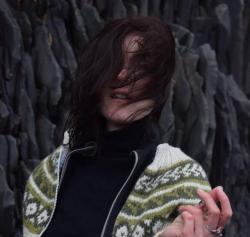Just beyond Iceland’s largest forest and by the southern tongue of a long, slender lake purported to house a cryptid serpent, Skriðuklaustur writes its history. Once a 16th-century monastery and, more recently, home to Icelandic author Gunnar Gunnarsson, Skriðuklaustur now marks its twentieth anniversary as a cultural centre in East Iceland.
The institute bustles with activities as a writer’s museum for Gunnar Gunnarsson, a fully-booked artist residency, a cultural centre, monastery excavation, and restaurant Klausturkaffi. “In the interview my wife and I gave in 1999, we said we would definitely leave the post in 5 years,” Skúli Björn Gunnarsson laughs, reflecting on his many years as the director of Skriðuklaustur and his wife Elísabet’s work running Klausturkaffi. “We thought we would be too exhausted after building it up from ground zero. And we were exhausted, but still enthusiastic. Fate brought us to Skriðuklaustur.”
Writer’s museum with a twist
“From the beginning, the institute board and I made it a policy that we would build it up as a cultural centre, in a more open way than a typical writer’s home like we can say Gljúfrasteinn is,” explains Skúli Björn, making reference to the writer’s museum of Halldór Laxness in Mosfellsdalur. “The institute was supposed to be not only the museum about the writer, but also to continue with his ideology. We were taking part in society more than a typical museum would do.”
Skúli Björn describes the institute’s mandate. “A typical writer’s home is a pilgrim’s place for the readers of that writer. As a target group for a dead author, that is usually only decreasing. It’s my opinion that a classical writer’s home as a museum and a pilgrim’s place is maybe not the best way to continue the legacy of the writer. Our ambitions were to spread the legacy of the writer and have more people read Gunnar Gunnarsson.”
Monastery excavation
A ten-year excavation (2002-2012) of a medieval monastery became the second major foundation for the institute. The name Skriðuklaustur indicated the monastery’s existence. “It was the last monastery established before 1500,” explains Skúli Björn, “and it only functioned for 60 years until the reformation to Protestantism. Then it disappeared as the buildings weren’t used anymore. When we started the institute, one of our questions was, ‘Where is the ruin from the monastery?’”
The ruin was located in 2000. “We now have one monastery totally excavated in Iceland.”
At home in words
As for their artist residency, applicants run the gamut of arts, including visual art, music and literature. The institute has been moving to offer increased residencies for writers and scholars, however, as residency accessibility throughout Iceland tends to favour visual artists. “We have priorities,” Skúli Björn admits. “If you are working with something related to Gunnar or East Iceland, then you rank a little higher on the application list.”
Visiting writers can apply for up to six weeks’ stay. It’s been an in-demand residency for the past twenty years, with at least 90% usage on an annual basis. “People are staying there even over Christmas, in the darkest months,” Skúli Björn remarks.

Influential solitude
The residency’s location offers a distinct benefit to working writers. “Our residency provides solitude and loneliness, up in the valley out of the town,” says Skúli Björn. “People who come here do so to finish their works and have some peace from the external world.”
Skúli Björn comments on the influence that Gunnar Gunnarsson’s works have on contemporary writers who stay in the residency. “Gunnarsson’s works are trying to get into the visiting writers’ works all the time,” he laughs.
Game for heritage
Skúli Björn has designed a new course for the University of Iceland this autumn, called ‘Gamification and Cultural Heritage’. His time is split between visits to teach in Reykjavík, and his directorial duties at Skriðuklaustur. The unexpected combination of gaming and heritage is influenced by an overseas collaboration on the medieval monastery and Skúli Björn’s work with Gunnar Gunnarsson’s legacy.
“Gunnar Gunnarsson was a really passionate player of the card game Lomber (or l’Hombre). The card game was close to extinction 20 years ago, so the institute decided to teach the game to new generations. It’s an old card game played on 40 cards, originating in Spain and France in the 15th century. It spread all over Europe as a gambling card game. In Iceland, we only play it in the winter. The old tradition was that you could only play it during months with ‘R’ in it—September through April.”
Extending life
Being able to actualise new editions of Gunnar Gunnarsson’s’ works helps support the overall project of Skriðuklaustur. “The writer’s family handed over the copyright to the institute, at least temporarily,” Skúli Björn explains. “That has been quite successful, because we have had a lot of new translations and editions of his works. ‘Advent’ was published in Italy two years ago and they have sold 10,000 copies already—good for a dead author. There’s also a new edition in French that will be published next year.”
Skúli Björn also notes multiple non-literary projects stemming from Gunnar’s writing. The Icelandic band Mógil will launch a CD inspired by Gunnar’s book ‘Advent,’ and there is also a film project for the same book in the financing stage. A TV series is in the works, inspired by another of Gunnar’s books, ‘Svartfugl.’
“He passed away in 1975, but he is still alive in his works,” says Skúli Björn. “I hope we can take some credit for that, after twenty years of the institute.”
Buy subscriptions, t-shirts and more from our shop right here!


















